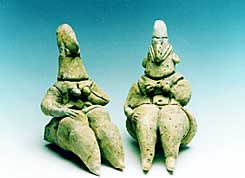Archeology / About 300 female figurines from the Neolithic period were found among the remains of one of the oldest cities in the world
Amiram Barkat, Haaretz

The statues of the fat women. were used for ritual purposes. Photo: David Haris
Direct link to this page: https://www.hayadan.org.il/shaarhagolanstatues.html
A group of figures of healthy, fleshy women from Kibbutz Sha'ar Golan, whose average age is about 8,000 years and whose height does not exceed 20 centimeters, is about to set an extraordinary achievement: soon they will be displayed simultaneously in the three most famous museums in the world - the Metropolitan in New York, the Louvre in Paris and the British Museum in London.
The "fat women" are clay figurines found at an excavation site on the banks of the Yarmukh, in the kibbutz fields south of the Sea of Galilee. The archaeologists estimate that the sculptures were created in the Neolithic period - the period when permanent settlements were established and plants and animals were domesticated, in the years 4,000-8,000 BC. A team of researchers from the Institute of Archeology of the Hebrew University, led by Dr. Yosef Garfinkel, discovered one of the largest ancient settlements in the world. The site covers an area of about 200 dunams (for comparison, the area of Jericho at that time did not exceed 50 dunams) and during its heyday, it is estimated that 2,000-1,000 people lived there.
Statuettes similar to those found at the Golan Gate were also discovered at various sites in Jordan, Lebanon and Israel. One figurine was discovered on Hashan Street in Tel Aviv. At the Golan Gate, the largest number of figurines was discovered, about 300 and some of them are particularly beautiful.
The figurines, whose hip circumference is four times larger than the normal circumference for their body dimensions, caught the eye of representatives of the Metropolitan in New York, who read about them in the press. Museum representatives were sent to Israel and took two figurines with them. In 2000, three similar figurines were sent to the Louvre in Paris, and recently the British Museum also expressed its desire for two figurines. All the statues are supposed to return to Israel five years after their delivery.
All the figurines were designed in the same position: one hand rests on the chest and the other rests on the wide pelvis. All figures have earrings, hair pulled back and a pointed hat. "The identity between the figures is the proof that the statuette was used for cult purposes, and not just as an art object," says Dr. Garfinkel. "It is a figure that has undergone a canonization procedure, similar, for example, to the figure of Jesus crucified in Christianity."
The character's type corresponds to the spirit of the time. According to Garfinkel, who specializes in the study of Neolithic society, religious worship in this period was divided into two levels: at the community level, a male figure was usually worshiped in the temples, while in the circle of the home and family the female figure dominated.
The main importance of the site where the figurines were found is in understanding the stages of the formation of the first cities in the world. The Neolithic settlement was actually a combination of a rural settlement and an urban settlement. Its inhabitants lived before the invention of writing and used flint tools, similar to the ancient man, but the level of architectural development they reached was not far from that of a city. Signs of urban planning were found in the settlement, such as straight streets and even "neighborhoods" - clusters of houses of similar size and shape.
Another interesting find is the settlement houses, which were built of mud and were unusual in size. "Houses discovered in urban settlements from later periods usually contained one or two rooms. Therefore, we believe that only the nuclear family was used," says Garfinkel. "In the houses of the settlement at the Golan Gate, on the other hand, there were eight, 10, and sometimes even 20 rooms or more - which indicates a clan family structure."
